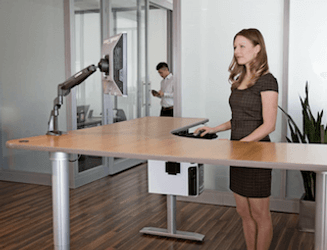Sit vs. Stand: Who Benefits from Sit-to-Stand Workstations?
Posted by Gene Kay, MS, CPE on 8th Jan 2017
Are you thinking of moving to a sit stand or standing desk workstation? Over the years I’ve met with ergonomics and facilities professionals at conferences and regional ergonomics meetings. At each of these gatherings we’ve talked about office inactivity and metabolic syndrome. Invariably the discussion has gone from the physiology of prolonged seated work to questions about how to respond to all of the requests for sit-to-stand solutions. Specifically these professionals are asking:
- Is there a cost-benefit business case for sit to stand?
- Who needs them, How do I accommodate the requests, How do I manage deployment?
- Once deployed, How do I ensure the sit/stand solution is fully utilized?
Introduction: Work has changed
Standing work has been around for millennia and during much of the industrial revolution many jobs were performed standing. However, more recently we've seen a significant increase in office jobs and seated computer work.
Not long ago a sit-down job was considered a nice achievement or accomplishment. It showed that you had risen above the need to ‘labor’ at work; you were climbing the corporate ladder.
Now the pendulum is swinging the other way and many experts believe that office inactivity is a significant health risk. Sitting has become so common that we now see average sit times of 9 hours per day, and many knowledge workers sitting for as much as 15 hours per day. Recent large population studies found a correlation with sit time and an increased risk of death. For example:
- An American Cancer Society study (2010) of 123,000 adults found that sitting more than 6 hrs during leisure time increased mortality by 37%.
- A study published by the American College of Sports Medicine (2009) found that those who sat the most had a 50% increased risk of early death, regardless of fitness levels.
Business Case: Adjustable workstations produce healthy ROI
Many sources demonstrate a positive return on investment for ergonomics programs, especially programs that include ergonomics training, individualized recommendations, and ergonomic furniture that can adjust to fit each individual.
- A previous The Ergonomics Report™ article, Evidence: Investing in Adjustable Workstations Produces Healthy ROI,showed a lower total cost of ownership and a significant return on investment for user-adjustable workstations at a global financial firm.
- A collection of 250 ergonomics case studies summarized by Rick Goggings of the WA State Dept. of Labor and the Puget Sound Human Factors and Ergonomics Society shows significantly reduced injury costs, improved productivity, and short pay-back periods for ergonomics programs and ergonomics furniture.
Who needs sit to stand - How do you accommodate the requests?
We know that office inactivity is bad for your health and we know that adjustable ergonomic furniture produces a positive return on investment, so how do we go from here?
First, recognize that not everyone needs a sit-to-stand desk.
- Movement, variety, and engaging the large muscles in the legs seem to be important to avoid the negative health effects of office inactivity. An individual that gets regular movement out of their seated workstation -- e.g., stand and walk more than 1-minute every 30 to 45 minutes -- may not need a sit to stand desk. Engaging the big leg muscles will kick-start the metabolism and provide many of the desired health benefits.
- People with orthopedic problems of the ankle, knee or hip may not be able to stand for extended periods.
- Individuals with jobs requiring precision control and movement with the hands will probably perform better seated. Examples include micro-assembly and some intensive design or graphics work.
- An ideal candidate for sit-stand desk might be someone who is tied to the computer or phone and can’t routinely get away from the desk.
Now, How do you deploy sit-to-stand?
Once you have identified the candidates for sit-stand solutions consider your budget, your work place requirements and these strategic options for rollout:
- Go Big: everyone gets sit-to-stand furniture and coaching & instruction on how/ when to use it. This has the highest initial cost but has been shown to produce very good results.
- Go Flexible: reduce your overall real estate footprint by deploying shared sit-to-stand workstations that two or more workers will use in combination with work from home, alternate shifts and periodic joint work in conference rooms etc. This can significantly reduce your real estate costs and produce excellent results with gains in productivity, retention, and engagement.
- Go Alternate: Leave the primary seated station unchanged and identify alternate stand-up areas for other tasks. This could be a small raised portion of the fixed cube for stand up work (paper work, secondary computer tasks, etc.). Central printers and recycling can encourage users to get up and walk, as can walking to more distant bathrooms and using stairs instead of elevators. This can produce some moderate results with a moderate budget.
- Go Small: If the previous options don’t fit your budget or work demands, then only deploy sit-to-stand for those with a qualifying medical need -- look for specific physician recommendations for conditions such as degenerative disc disorder, etc. This produces the least overall return on investment, but will help in individual cases and keep you in compliance with ADA regulations.
Now that you have sit-to-stand deployed, ensure they get used
Many sit-to-stand accommodations don’t get fully utilized; the drive to stand can fade like a failed diet or fitness resolution. Folks are often excited and use it for a month or two, but then stop making the sit-to-stand adjustment. Common issues to address include:
- Noisy, slow or otherwise inconvenient adjustments between sitting and standing heights. To avoid this carefully evaluate the proposed sit-to-stand furniture. Test it in the production environment loaded with typical computer equipment. If your sit-to-stand solution has these characteristics users may not make regular adjustments. For example, manual hand crank style adjustable desks usually require so many turns that users simply stop using them.
- Foot & leg fatigue or discomfort. To prevent or fix this problem suggest gradual increases in standing time combined with regular sit periods. Start with 10 min. stand and 20 min. sit and slowly build up to 30 or 40 min. stand and equal sitting. Suggest supportive athletic shoes for standing, also suggest compression socks – they are popular among health care workers and distance runners. A footrest can help -- alternately raising a foot up on a box or footrest changes the active muscles and relieves the back.
- Cultural, social pressure or noise disruptions. standing workers don’t want to look weird and don’t want to create visual or noise disturbances if they are the only ones standing. Consider some strategically placed privacy or sound barriers on top of cube walls if a neighboring sit-to-stand is a nuisance.
Summary
There are many potential benefits of sit-to-stand and user adjustable furniture including lower total cost of ownership, fewer MSD’s, higher productivity, improved satisfaction, shared workstation accommodations, multi-shift work, and flexible work arrangements. However, to get the greatest benefit for the employee and the company, you need to ensure that you deploy the right equipment to the right population, and then support roll-out by giving users encouragement and guidance in how to be comfortable and successful with the new equipment.
References
Alpa V. Patel, Leslie Bernstein, Anusila Deka, Heather Spencer Feigelson, Peter T. Campbell, Susan M. Gapstur, Graham A. Colditz, and Michael J. Thun (2010). Leisure Time Spent Sitting in Relation to Total Mortality in a Prospective Cohort of US Adults, American Journal of Epidemiology, 172(4). DOI: 10.1093/aje/kwq155
Katzmarzyk PT, Church TS, Craig CL, Bouchard C (2009). Sitting Time and Mortality from All Causes, Cardiovascular Disease, and Cancer, Med Sci Sports Exerc. 2009 May;41(5):998-1005.
Gene Kay has a Masters Degree in Exercise Science and is a Certified Professional Ergonomist (CPE, BCPE). He is the Director of Ergonomics for Velocity EHS.

